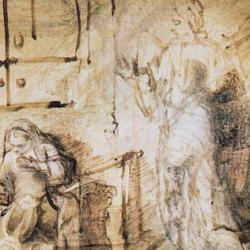Masudi’s 10th-century Meadows of Gold and Mines of Gems gives the history of the world from Eden to the author’s own time. His account of early humanity is clearly drawn partly from Genesis, but other accounts are thoroughly mixed in.
When God determined to create Adam as a “lieutenant on earth,” he sent Gabriel and then Michael to gather some clay for him to turn into Adam. They failed, so God sent the angel of death, who was so fierce that the earth fled away to heaven, where God could get his hands on it: “he took black, red, and white earth; for this reason the sons of Adam are of different colours. The first man was called Adam fore he was taken from the surface (adim) of the earth.”
In this version, God doesn’t just form a man and breath into his nostrils. It’s a much longer process: “When God had kneaded together the dust, he left it for forty years, till it had become tenacious clay; then he left it other forty years, till it got foetid and altered. . . . Then he gave to the lay the form of man, but left it without a soul; it made a jingling noise, like an earthenware vessel, so it remained a hundred and twenty, or, according to other authorities, forty years.” Iblis – an angel who became Satan – went into the thing’s mouth and out the back, and was rebuked.
Finally, God breathed “soul into Adam” and then ordered the angels to bow in worship toward the man. All but Iblis did, and this was the beginning of Satan’s rebellion. The breathing of the soul into Adam was on a Friday, the sixth of Nisan. Masudi makes only a passing reference to Eve: “Then Eve was created from Adam,” and he quickly moves on to describe paradise.
People of the book, it seems, can differ quite dramatically in how they read the book.















